Whistler’s colder temperatures and extended snowpack are limiting green-up and grazing areas for emerging bears. As of May 13, I have identified a minimum of 28 bears (18M, 10F) below 800-metres elevation through valley bottom. Green-up is about 1-2 weeks behind in the valley and 3-4 weeks behind in the ski areas.
Skunk cabbage, pussy willows, grass, clover, and dandelions are available in the valley but, extended snowpack from an above normal snowfall in the valley with a very gradual thaw is covering almost all of early to mid-May feeding sites on lower ski trails. Expect bear activity to climb through May as bears are forced to crowd valley bottom feeding areas.
Vaccinium (huckleberry and blueberry) phenology is already 1-3 weeks behind. Vaccinium is the most important berry to Whistler bears and is too often susceptible to failed or late crops due to extreme scales of weather (too much rain or sun).
Our bear population is uniquely adapted to feeding in recreation areas. When you begin to walk, jog, bike, ride, or golf remember, recreation areas overlap high quality seasonal bear feeding areas. Many bike trails and all golf courses are in prime spring feeding space. Bears become habituated to our presence (and less secure open areas) each spring to benefit the easily digested young plants. And in spring, all bears are stressed and many are underweight — hibernation is not an easy accomplishment.
When golfing, give bears lots of space and do not approach to take closer photographs. Take photos from where you are on the green. Most bears graze along the fairway and along the fairway’s perimeter on grass, clover, and dandelions. Keep your food (on the cart) to a minimum and use the garbage containers (but not if they are overflowing). We want the bears to use the green-up on a course, but not to associate a golf course with garbage.
Walking up and photographing bears can sometimes trigger curiosity in the bear. Male bears have often approached and even followed a person for a short distance (while hiking, walking, or golfing). If a bear does approach, get a bunch of people together and shout at him waving your arms. Golf courses have excellent forage value for bears and I have known at least 10 large dominant males for greater than eight years that have thrived on courses each spring while causing no conflicts elsewhere. Golf courses should be responsible to have staff instructed each spring on bear behaviour and how to mitigate potential conflicts. Golf courses will receive high bear activity through May and June.
Mountain bike trails, for obvious reasons, meander through all seasons of bear habitat. I have even seen bike trails constructed right in front of the entrances to winter dens. Bikes offer the greatest intrusion into bear space because of the speed and frequency in which they have the potential to startle bears. Bikes can be quiet on trails with poor visibility, which also leads to sudden encounters. Noise makers on bikes help if you are riding near skunk cabbage swamps or concentrated green-up. The human voice is always best over or in combination with bells.
Line of sight is a good measure of when to make noise. If you can see a good 20 metres you can be aware, but if trails become windy and visibility is less than 10 metres, the bear should be aware of the approach of a human.
Most bears have experience with the sounds and speed of mountain biking but bears can often be distracted by feeding, young, and other bears.
Joggers should also be aware by not wearing ear phones (for music) when running or walking through seasonal feeding areas. Bears often huff, snort, and flee when startled. Listening to music masks the bear’s responsive warning leading you into a situation where a bear has not fully retreated or a mother that may be standing ground (at the base of the tree) while her cubs are climbing.
When encountering bear families, you often will hear the cubs climbing the tree (claws on trunk) and huffing before you hear the mother. Look for swaying branches and do not approach the base of the tree. Always speak to bears and retreat the way you came.
Expecting mothers (with cubs-of-the-year) have been emerging from dens during the first week of May. Of the ski area’s population of 15 adult females, nine should emerge with yearlings, or in Katie and Zoë’s case, 2 year olds.
Jeanie, Amy, Katie, Alice, and Elly have emerged. Jeanie and Amy (with 1 yearling each) are the only mothers to have moved into the valley.
Six females were expected to have cubs. Marisa, the oldest female on Blackcomb emerged without cubs. I am currently watching for the remaining five mothers. Due to a poor berry crop from a cool, rainy summer in 2007, followed by a long winter extending into spring, cub production is likely going to be low this year and mortality may exist in older and younger bears.
Please keep your garbage inside and dump it frequently at the two bear-proof compactors, at Function Junction or Nesters. Don’t put garbage into overflowing containers and report unchecked garbage to the RMOW Bylaw Services.
This spring, Millennium Place is hosting my “Mother Bear Exhibit” through May including the presentation “Jeanie’s Journey” on May 24 th that profiles the adaptive life of Whistler’s most popular mother bear.
Questions about bear behavior or identity please call me at 604-698-6709 or e-mail mallen_coastbear@direct.ca




